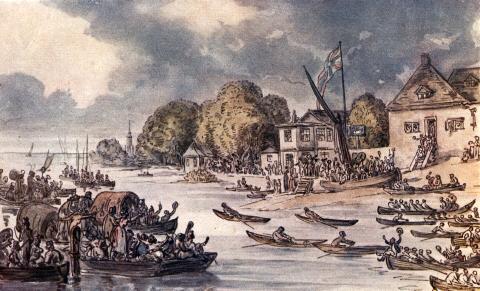The Origins Of The Race For Doggett’s Coat and Badge

With roads narrow, congested, and poorly maintained and London Bridge the only dry crossing over the Thames until well into the eighteenth century, the easiest way to travel around the capital was by water. Ferries ran at various points along the river, large enough to transport horses and wagons as well as pedestrians. Alternatively, four-passenger wherries could be summoned from the many stairs that led down to Thames. For those wishing to travel along rather than across the river, long ferries ran the length of the river from Chelsea in the west to Greenwich in the east.
Ferry franchises were lucrative and held by the Crown or aristocrats, who leased them out to a waterman. Being a waterman was a skilled occupation requiring a detailed knowledge of the tides and currents of the river as well as the ability to handle a heavy boat in all weathers. It was also extremely competitive, watermen congregating around the stairs, jostling for trade, crying “oars, oars, scull, oars, oars”.
John Stow’s A Survey of London (1596) gives an idea of the volume of river traffic and the numbers employed. “There pertaineth”, he wrote, “to the cities of London, Westminster, and borough of Southwark, above the number, as is supposed, of 2,000 wherries and other small boats, whereby 3,000 poor men, at the least, be set on work and maintained”. London’s population at the time was around 200,000.
The first attempts to impose some order on ferries were made in the 16th century with the passing of a statute in 1514 regulating fares and an Act of Parliament in 1555 establishing the Company of Watermen. A City Guild rather than a Livery Company, it introduced a one-year apprenticeship for passenger-carrying watermen plying their trade between Windsor and Gravesend.
The preamble to an Act of Parliament in 1603 openly criticised watermen stating that people travelling between Windsor and Gravesend “have been put to great hazard and danger and the loss of their lives and goods, and many times have perished and been drowned in the said River through the unskilfulness and want of knowledge or experience in the wherrymen and watermen”. Henceforth, watermen carrying passengers had to be at least eighteen years old and to have completed an apprenticeship lasting seven years. They were then entitled to become a freeman of the Company.
Dublin-born Thomas Doggett used his thespian talents to good effect, becoming “the leading low comedian of the London stage” and later an impresario, managing the Theatre Royal, Drury Lane, and the Haymarket Theatre. By the time he retired in 1713 he had amassed “a fortune sufficient for the rest of his life”.
A staunch Whig, a fervent supporter of the Hanoverian cause, and inspired, it is said, by an encounter with a newly qualified waterman who was the only one prepared to take him across the Thames on a foul night, Doggett placed a placard on London Bridge on July 31, 1715, the eve of the first anniversary of George I’s accession to the British throne. It read “there will be given by Mr Doggett an orange colour livery with a badge representing Liberty to be rowed for by six watermen that are out of their time within the year past. They are to row from London Bridge to Chelsea. It will be continued annually on the same day for ever”. The Brunswick Coat and Badge Wager, later known as the Race for Doggett’s Coat and Badge or the Wager, was born.



